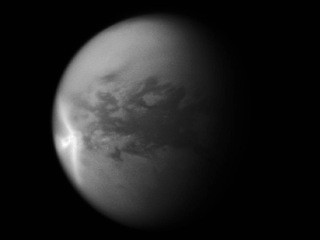Scientists Solve Titan's Arrow-Shaped Cloud Mystery

Saturn's largest moon, Titan, has what looks like an enormous white arrow about the size of Texas on its surface, and scientists at UCLA believe they have solved its mystery.
They did so by using a global circulation model of Titan to show how planetary-scale atmospheric waves affect the moon's weather patterns, leading to a "stenciling" effect that results in sharp and sometimes surprising cloud shapes.
The study was led by Jonathan Mitchell, UCLA assistant professor of earth and space sciences and of atmospheric and oceanic sciences. It is published in the Aug. 14 online edition of the journal Nature Geoscience.
"These atmospheric waves are somewhat like the natural, resonant vibration of a wine glass," Mitchell said in a statement. "Individual clouds might 'ring the bell,' so to speak, and once the ringing starts, the clouds have to respond to that vibration."
The fascinating clouds, including arrow-shaped formations resulting from the atmospheric waves can cause intense precipitation that is sometimes more than 20 times Titan's average seasonal rainfall, and could be essential in shaping Titan's surface by erosion.
The researchers described Titan's climate is "all-tropics," as the entire planet experiences the types of weather phenomena confined to the equatorial region of the Earth.
"Our new results demonstrate the power of this analogy, not only for general features of Titan's climate but also for individual storms," Mitchell said. "In future work, we plan to extend our analysis to other Titan observations and make predictions of what clouds might be observed during the upcoming season."
He added that Titan's "all-tropical" climate gives the opportunity to study tropical weather in a simpler setting other than on Earth.
"Our hope is that this may help us understand Earth's weather in a changing climate," Mitchell added.
"Titan is like Earth's strange sibling - the only other rocky body in the solar system that currently experiences rain," Mitchell said.
© Copyright IBTimes 2024. All rights reserved.






















